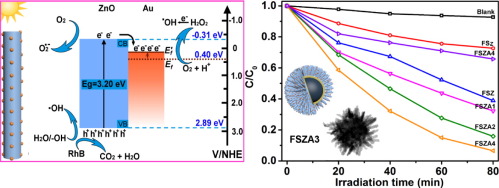当前位置:
X-MOL 学术
›
Powder Technol.
›
论文详情
Our official English website, www.x-mol.net, welcomes your
feedback! (Note: you will need to create a separate account there.)
Controlled preparation of superparamagnetic Fe 3 O 4 @SiO 2 @ZnO-Au core-shell photocatalyst with superior activity: RhB degradation and working mechanism
Powder Technology ( IF 4.5 ) Pub Date : 2018-03-01 , DOI: 10.1016/j.powtec.2017.12.088 Dandan Wang , Donglai Han , Jinghai Yang , Jian Wang , Xiuyan Li , Hang Song
Powder Technology ( IF 4.5 ) Pub Date : 2018-03-01 , DOI: 10.1016/j.powtec.2017.12.088 Dandan Wang , Donglai Han , Jinghai Yang , Jian Wang , Xiuyan Li , Hang Song

|
Abstract The designed synthesis of advanced ZnO heterostructures in a simple and mild way is of great significance, for the purpose of improving their photocatalytic performance and large-scale applications. Herein, a magnetic hierarchical microsphere Fe3O4@SiO2@ZnO@Au (FSZA) was successfully synthesized by multistep chemical methods, in which magnetic Fe3O4@SiO2 as core for the growth of ZnO nanorod-layer using microwave-assisted approach, followed by the functionalization of Au nanoparticles (NPs). Four FSZA microspheres (FSZA1, FSZA2, FSZA3, FSZA4) were controlled prepared by adjusting the concentration of the Au precursor for comparison. The as-prepared products were characterized SEM, TEM, XRD, VSM, N2-sorption, photocurrent and XPS techniques. The results revealed that the as-synthesized microspheres have a good monodispersity, uniform core-shell structure and high magnetization. The photocatalytic test indicated the FSZA3 product possessed the best activity among all tested products, and the photodegradation rate of rhodamine B (RhB) reached 93.54% after UV irradiation of 80 min. The enhanced activity of FSZA3 was ascribed two major contributions, which were the larger specific surface area and the improved separation efficiency of the photogenerated carriers. The decomposition mechanism was discussed in detail. Additionally, such integrated FSZA3 photocatalyst was easily recovered by a magnet, which was reused at least five times without any appreciable reduction in photocatalytic efficiency.
中文翻译:

超顺磁性Fe 3 O 4 @SiO 2 @ZnO-Au核壳光催化剂的可控制备:RhB降解及工作机理
摘要 以简单温和的方式设计合成高级ZnO异质结构对于提高其光催化性能和大规模应用具有重要意义。在此,通过多步化学方法成功合成了磁性分级微球 Fe3O4@SiO2@ZnO@Au(FSZA),其中磁性 Fe3O4@SiO2 作为核心用于使用微波辅助方法生长 ZnO 纳米棒层,然后进行功能化金纳米粒子 (NPs)。通过调节 Au 前驱体的浓度控制制备了四种 FSZA 微球(FSZA1、FSZA2、FSZA3、FSZA4)以进行比较。所制备的产品通过 SEM、TEM、XRD、VSM、N2 吸附、光电流和 XPS 技术进行表征。结果表明合成的微球具有良好的单分散性,核壳结构均匀,磁化强度高。光催化试验表明,FSZA3产品在所有测试产品中活性最好,紫外线照射80分钟后罗丹明B(RhB)的光降解率达到93.54%。FSZA3 的活性增强归因于两个主要贡献,即更大的比表面积和光生载流子分离效率的提高。详细讨论了分解机制。此外,这种集成的 FSZA3 光催化剂很容易被磁铁回收,可重复使用至少五次,光催化效率没有任何明显降低。紫外光照射80 min后,罗丹明B(RhB)的光降解率达到93.54%。FSZA3 的活性增强归因于两个主要贡献,即更大的比表面积和光生载流子分离效率的提高。详细讨论了分解机制。此外,这种集成的 FSZA3 光催化剂很容易被磁铁回收,可重复使用至少五次,光催化效率没有任何明显降低。紫外光照射80 min后,罗丹明B(RhB)的光降解率达到93.54%。FSZA3 的活性增强归因于两个主要贡献,即更大的比表面积和光生载流子分离效率的提高。详细讨论了分解机制。此外,这种集成的 FSZA3 光催化剂很容易被磁铁回收,可重复使用至少五次,光催化效率没有任何明显降低。
更新日期:2018-03-01
中文翻译:

超顺磁性Fe 3 O 4 @SiO 2 @ZnO-Au核壳光催化剂的可控制备:RhB降解及工作机理
摘要 以简单温和的方式设计合成高级ZnO异质结构对于提高其光催化性能和大规模应用具有重要意义。在此,通过多步化学方法成功合成了磁性分级微球 Fe3O4@SiO2@ZnO@Au(FSZA),其中磁性 Fe3O4@SiO2 作为核心用于使用微波辅助方法生长 ZnO 纳米棒层,然后进行功能化金纳米粒子 (NPs)。通过调节 Au 前驱体的浓度控制制备了四种 FSZA 微球(FSZA1、FSZA2、FSZA3、FSZA4)以进行比较。所制备的产品通过 SEM、TEM、XRD、VSM、N2 吸附、光电流和 XPS 技术进行表征。结果表明合成的微球具有良好的单分散性,核壳结构均匀,磁化强度高。光催化试验表明,FSZA3产品在所有测试产品中活性最好,紫外线照射80分钟后罗丹明B(RhB)的光降解率达到93.54%。FSZA3 的活性增强归因于两个主要贡献,即更大的比表面积和光生载流子分离效率的提高。详细讨论了分解机制。此外,这种集成的 FSZA3 光催化剂很容易被磁铁回收,可重复使用至少五次,光催化效率没有任何明显降低。紫外光照射80 min后,罗丹明B(RhB)的光降解率达到93.54%。FSZA3 的活性增强归因于两个主要贡献,即更大的比表面积和光生载流子分离效率的提高。详细讨论了分解机制。此外,这种集成的 FSZA3 光催化剂很容易被磁铁回收,可重复使用至少五次,光催化效率没有任何明显降低。紫外光照射80 min后,罗丹明B(RhB)的光降解率达到93.54%。FSZA3 的活性增强归因于两个主要贡献,即更大的比表面积和光生载流子分离效率的提高。详细讨论了分解机制。此外,这种集成的 FSZA3 光催化剂很容易被磁铁回收,可重复使用至少五次,光催化效率没有任何明显降低。











































 京公网安备 11010802027423号
京公网安备 11010802027423号